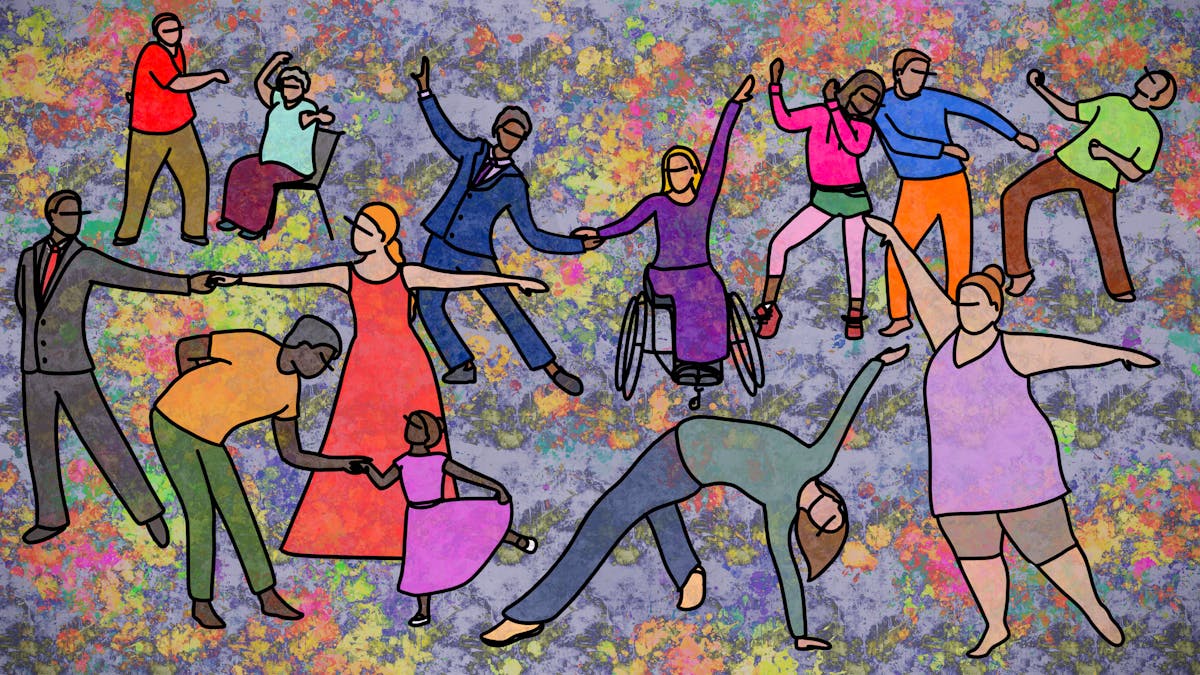People dance when they are happy but, as dance psychologist Peter Lovatt reveals, dancing results in a potent cocktail of feel-good brain chemicals, greater social bonding and enhanced creativity, all of which will keep you dancing for joy.
Dancing for joy
Words by Dr Peter Lovattartwork by Jem Clancyaverage reading time 5 minutes
- Article

Dancing fills me with joy; it always has. In 1982 I’d walk into the Pink Elephant nightclub in Southgate, north London, and Wham! would hit me in the chest, explode through my body, and I’d dance in a euphoric state for hours.
I was a bedroom dancer first, then a clubber, then a jazz-dance junkie and now a kitchen groover. Throughout my life, in hundreds of environments, with thousands of people, dance has produced a consistent feeling in me – it has filled me with joy.
Thousands of people have told me why they do and don’t dance. Here's how one woman in her early 20s described how it makes her feel:
“I love dance. It allows me to escape reality and enter another world. It helps me to deal with problems or issues I have. I can put all of my emotions of the day into it, whether I am happy or sad or angry or upset, and when I leave the studio, I feel a weight lifted from my body. It is my way of releasing stress and built-up tension.”
The perfect dance mix
There are several reasons why grooving makes us feel so fabulous. The potent mix of biological, social and cognitive stimulation that happens when we dance creates the perfect emotional martini. It’s a couple of measures of brain-juice, one of social bonding and a half measure of clear thinking, with a twist.
One of the reasons we get such an emotional high from dancing is because of the neurotransmitter dopamine – a chemical released by brain cells. Dopamine is related to both movement and feelings. It plays a role in how we feel, and low levels of dopamine are associated with feelings of anxiety, hopelessness, fatigue, pain, and mood swings.
Dancing to music is a great way to overcome these negative feelings because both the physical exercise and the emotional response to the music can lead to the release of dopamine in different parts of the brain. As dopamine levels go up, we can shake off some of those negative feelings and float towards euphoria.
Dancing also raises our pain threshold – how else could people dance for hours in ill-fitting shoes? Scientists at Oxford University think that our innate pain-relieving system – the endogenous opioid system – might be working overtime when we dance. Our brain produces opioids, which are painkillers with a natural ‘high’, and they can make us feel fantastic.
“The potent mix of biological, social and cognitive stimulation that happens when we dance creates the perfect emotional martini.”
Join the dance
Research suggests that increased activation of the endogenous opioid system during dancing might also make us feel good about the people we are dancing with.
A group of dancing dons at Oxford University tested the relationship between dancing, pain and social bonding, and found that they were related. They asked people to dance in different ways and then tested how much pain they could tolerate.
People were taught some simple dance moves and then divided into groups. Some groups were instructed to do the same dance moves at the same time (same-dance group), and other groups had to dance independently of each other (different-dance group). The researchers then measured people’s pain thresholds, and asked them how socially bonded they felt to the people they were dancing with.
What they found was very surprising. After everyone had danced, there were huge differences between the same-dance groups and the different-dance groups. Those in the same-dance groups could cope with more pain and felt more socially bonded to the people they were dancing with, compared with those people in the different-dance groups.
Dancing together gives us a natural high because it leads to increased activation of our endogenous opioid system. This makes us feel positively inclined towards the people we are dancing with, as well as feeling pleasure. It is no wonder that people fall in love when they dance.
Dance for inspiration
Moving our body also changes the way we think and solve problems, and this is related to our mood and feelings. This is why people report feeling free of their daily worries and anxieties when they dance.
Researchers at Sheffield and York universities carried out a study into the relationship between dance, exercise, mood and creativity. They measured people’s mood and creativity before and after they spent just five minutes either listening to music, dancing, cycling or sitting quietly.
Those in the dancing group showed significant increases in feelings of happiness and significant decreases in negative feelings. For those in the cycling group, there were no significant changes in either positive or negative mood.
Changes in mood seemed also to be related to changes in thinking and creativity. For the dancers, increases in positive feelings were associated with increases in verbal creativity. Verbal creativity was measured by asking people to think of as many alternative uses for a common object (for example, a brick or a can) in a short period of time.
The study suggests that while five minutes of dancing and cycling can lead to similar physiological changes, only dancing leads to improvements in mood and associated positive changes in verbal creativity and thinking.
Dance your troubles away
The joy of dancing is that it gives us a natural high, and moving in synchrony with others raises our pain threshold and makes us feel more positive towards the people we are dancing with. Dancing also changes the way we think and solve problems, all of which can help us to forget our troubles and get happy.
About the contributors
Dr Peter Lovatt
Dr Peter Lovatt is a dance psychologist. He worked as a professional dancer before studying psychology at university. During his 25-year academic career, Peter was a research psychologist at Cambridge University and taught Dance Psychology at the Royal Ballet School. Peter is the author of two books: ‘The Dance Cure’ (2020) and ‘Dance Psychology: The Science of Dance and Dancers’ (2018). Peter is currently the Director of Movement in Practice, which aims to enhance the human experience in business, education and healthcare through movement.
Jem Clancy
Jem is a visual and movement artist based in Leeds. She is passionate about dance and art as a means to communicate and connect with others. As a disabled artist she is particularly keen to embrace and promote diversity and inclusion throughout her work, in all processes and product. She is currently an associate artist with the Tetley Art Gallery and works at Northern Ballet supporting the Academy and the delivery of Ability, a weekly training course for adults with learning disabilities, in the Learning team.

